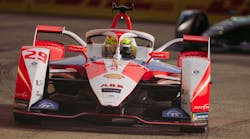This article appeared in Machine Design and has been published here with permission.
For Part 2 of the series, go here, and for Part 3, go here.
Lewis Butler joined Mahindra Racing in 2015 and is now the team’s technical lead on the Formula E program. He oversees the technical aspects of the team’s racing program and ensures the car meets all technical regulations while striving to improve its performance. He recently answered some questions we at Machine Design had regarding the car’s battery pack.
Machine Design: Do all Formula E race teams use the same battery packs with the same make and model and number of cells?
Lewis Butler: Correct, all Formula E cars use the same main traction battery, the current Gen2 packs in use since the 2018/19 season five. They all have the same type and number of cells. Total usable energy is 54 kWh and they put out about 200 kW during a race, but they can crank out a peak power of 250 kW when qualifying.
MD: Is the same battery pack used throughout a single race? Or can teams swap out a used pack for a fully charged one?
LB: Each car uses one pack during the 80-100 kilometers (50 to 65 miles, or 30 to 40 laps) of the race. Formula E races are time-based and last 45 minutes plus one lap. There is no time to swap out the pack even if the need were to arise. It is also a key part of the car structure. The packs are regularly charged during each running day and it is strictly regulated by FIA officials (the sport’s governing body), with set charging “windows” between practice sessions and, crucially, after qualifying. That way, the pack is in the best possible condition for the race.
MD: Do teams use the same battery pack for the entire racing season?
LB: Teams rely on the same battery pack throughout the season, unless a technical/safety issue is identified. Then the team installs a replacement pack.
MD: How much do the battery packs cost? Who makes them? What kind of chemistry do they use?
LB: Battery packs are supplied to the Formula E by UK-based McLaren Applied Technologies and cost over $235,000 per unit. They use cylindrical cells with Li-ion chemistry of the NMC (nickel manganese cobalt) variety.

